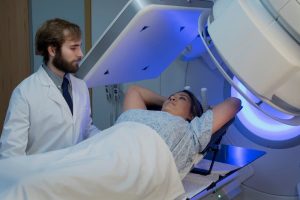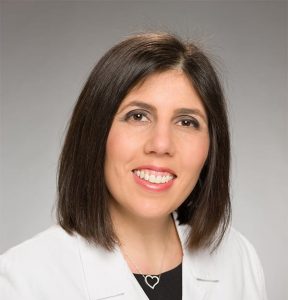
Radiation Therapy for Breast Cancer: How Does It Work?
Breast cancer is the second most common cancer affecting women in the United States, with only skin cancer occurring more often. Patients with breast cancer
HIPAA Alert: Potential Data Breach Learn More
Questions on Oncology, Hematology and/or Infusion Clinical Services due to COVID-19 Crisis – CALL 833-698-1623
Important Information for Our Patients Regarding the Coronavirus.
RCCA Providing Area Cancer Patients with Access to Care During Coronavirus Outbreak
RCCA Offering Patients Virtual Visits During Coronavirus Pandemic
Lung cancer develops when the cells that line the lungs are repeatedly damaged (often because of smoking). Over time, these damaged cells begin to act abnormally, and malignant tumors can develop. The two major types of lung cancer are non-small cell lung cancer (NSCLC) and small cell lung cancer (SCLC). NSCLC is much more common than SCLC, accounting for about 80 percent to 85 percent of lung cancer cases.
Located in New Jersey, Connecticut, Maryland, and the Washington, D.C., area, Regional Cancer Care Associates (RCCA) has extensive experience treating all types of lung cancer, including NSCLC. Learn more about NSCLC, risk factors, and treatment options.
Non-small cell lung cancer (NSCLC) is an umbrella term for several types of lung cancer. Typically, NSCLC grows and spreads more slowly than SCLC. Most cases of NSCLC are caused by smoking.

The three primary types of NSCLC are:
There are also other rare subtypes of NSCLC, such as sarcomatoid carcinoma.
Risk factors for NSCLC include:
Early stages of NSCLC may not cause any noticeable symptoms. As NSCLC progresses, common signs and symptoms can include:
If lung cancer is suspected, several different tests may be needed to rule out other conditions. In addition to reviewing a patient’s medical history and completing a physical examination, a provider may order:
Additional tests, such as blood work and urinalysis, may also help confirm a diagnosis of NSCLC.
Once a patient has been diagnosed with NSCLC, a physician will determine the stage, which indicates how far the cancer has advanced and informs a treatment plan. Lung cancer stages are indicated with Roman numerals running from 0 to IV:
The five-year survival rate for patients with early-stage NSCLC is 63 percent.
A patient’s treatment plan will depend on several factors, including the cancer stage and the person’s overall health. Common treatment options include:
Surgery is often the preferred treatment option for early-stage NSCLC. Depending on the location and size of the tumor, surgery may involve the removal of an entire lobe of the lung (lobectomy) or a larger part of the lung (known as lung resection).
Radiation therapy uses focused, high-energy X-ray beams to kill cancer cells or slow their growth. Radiation therapy may be used in combination with other treatments, such as chemotherapy or surgery.
Chemotherapy is a common cancer treatment that uses drugs to stop cancer cells from growing. Some patients receive chemotherapy intravenously, while others take oral medications. With both forms of treatment, the drugs travel through the bloodstream to act against cancer cells in the lungs or other parts of the body.
Targeted therapy uses drugs that are designed to identify and attack cancer cells that have specific genetic mutations. This helps slow the spread of NSCLC. This is an increasingly utilized form of treatment, and there are many types of targeted therapy drugs.
Immunotherapy is a cancer treatment that uses medication to harness the power of a patient’s immune system. Some immunotherapy drugs work by boosting the body’s ability to identify and kill cancer cells. Others block the proteins that prevent T cells from attacking cancer cells.
Cancer treatment plans are personalized for each patient. Often, a multidisciplinary approach to care is used, in which medical oncologists, surgeons, and radiation oncologists work together. For example, a patient may undergo a course of radiation before surgery to help shrink tumors. Other providers, such as counselors or dietitians, may also work with the patient to provide supportive care.
Cancer treatments such as chemotherapy and radiation can cause side effects. Some common side effects and strategies for mitigating them include:
Cancer can also take an emotional and psychological toll. Patients are encouraged to talk with their providers about the types of mental health support and services available to them.
There are plenty of strategies to help patients through the process of NSCLC treatment and survivorship. These include:
Quitting smoking is the best way to reduce one’s risk of lung cancer. Patients who want help stopping smoking should ask their primary care provider for smoking cessation resources. Those who have a history of smoking should also talk with their provider about getting screened for lung cancer. Annual screenings are recommended for certain patients and help with the early detection of lung cancer, which can improve treatment outcomes.
Cancer care continues even after a patient’s scans are clear. Long-term monitoring is required to check for recurrence or secondary cancers. Unfortunately, patients with NSCLC are at higher risk of developing a second lung cancer. A patient’s oncology team will set a schedule for ongoing monitoring.
It is normal to struggle with survivorship. Patients may feel a mixture of relief, guilt that they survived when other people with cancer did not, and anxiety that their cancer will come back. Joining other survivors in an online or in-person support group can help patients navigate these complicated emotions.
Fortunately, promising advances in NSCLC research and treatment are offering hope to patients with cancer. Individuals throughout New Jersey, Connecticut, Maryland, and the Washington, D.C., area count on the experienced medical oncologists at Regional Cancer Care Associates. Providing evidence-based care for all cancer types, malignant blood disorders, and benign blood disorders, the RCCA team creates personalized treatment plans for each patient. With over 20 locations, patients can receive advanced care close to home. For more information or to schedule an appointment, contact RCCA today.
If you or a loved one is battling non-Hodgkin lymphoma, you aren’t alone. Our experts at Regional Cancer Care Associates are dedicated to delivering accurate diagnoses and effective treatments. To find out more or make an appointment, get in touch with us at one of our locations throughout Connecticut, Maryland, and New Jersey.

Breast cancer is the second most common cancer affecting women in the United States, with only skin cancer occurring more often. Patients with breast cancer

Women 64 and younger now have higher rates of cancer than men. Read insights from oncologists at Regional Cancer Care Associates.

This passion and dedication was once again recognized when 16 doctors from RCCA were named 2023 Top Cancer Doctors as selected by health care research and information company Castle Connolly.

Regional Cancer Care Associates is one of fewer than 200 medical practices in the country selected to participate in the Oncology Care Model (OCM); a recent Medicare initiative aimed at improving care coordination and access to and quality of care for Medicare beneficiaries undergoing chemotherapy treatment.